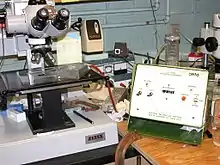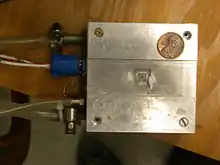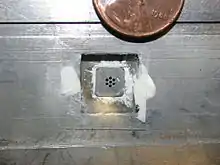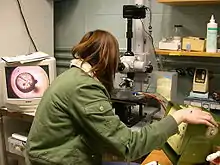Clifton nanolitre osmometer
A Clifton nanolitre osmometer is a device that allows the determination of the melting and freezing point of an aqueous solution using a sample size of only nanolitres. The device consists of a controller box, a cooling stage, and a sample holder. Additionally, various microliter syringes, immersion oils and microscopes are required for its use.

Cooling of the stage is achieved with the use of Peltier devices inside the cooling stage.
The Clifton nanolitre osmometer is especially well suited for determining the antifreeze activity or thermal hysteresis of a solution, which is a difference in the melting and freezing point of a solution. This phenomenon arises when biological antifreeze proteins are present in a solution. Solutions that do not contain antifreeze proteins generally have identical freezing and melting points.
Operation



A melting and freezing point determination consists of the following steps:
- Calibration: The device should be calibrated with solutions of known osmolarity, typically a 2-point calibration is used.
- Loading: Each of the wells in the sample holder are filled with a "heavy" immersion oil. A small amount (generally 1-2nL) of solution is pipetted or blown into the oil in the wells using a microliter syringe or a pulled capillary tube.
- Deep Freeze: The stage is cooled to a temperature of around -40 degrees Celsius (-40 °F) very quickly (~20 seconds), which causes the samples in the sample wells to flash-freeze.
- Determinations: The samples are allowed to melt relatively slowly, under the control of the osmometer controller. The temperature of the sample (solution) at the point when the last ice crystal disappears is called the melting point. The samples are refrozen using the deep freeze, and once again melted towards a single ice crystal. When only a single, very small ice crystal remains the samples are cooled in a controlled manner using the nanoliter control box. The temperature of the solution at the point when the ice crystal grows is called the freezing point.
Uses for the Clifton nanolitre osmometer

It can be used to determine the osmolarity (saltiness) of very small volumes of aqueous solutions such as tears, biological samples or plant fluids. It can also be used to determine the antifreeze activity or thermal hysteresis in a solution, such as fluids from polar fish, overwintering insects, cold-hardy plants, any fluid that contains antifreeze proteins.